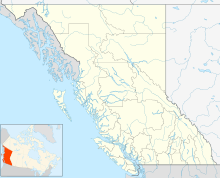19 Wing Comox
|
CFB Comox Comox Airport |
|||||||||||||||||||
|---|---|---|---|---|---|---|---|---|---|---|---|---|---|---|---|---|---|---|---|
 |
|||||||||||||||||||
| Summary | |||||||||||||||||||
| Airport type | Military | ||||||||||||||||||
| Owner | Government of Canada | ||||||||||||||||||
| Operator | DND/Comox Valley Airport Commission | ||||||||||||||||||
| Location | Comox, British Columbia | ||||||||||||||||||
| Time zone | PST (UTC−08:00) | ||||||||||||||||||
| • Summer (DST) | PDT (UTC−07:00) | ||||||||||||||||||
| Elevation AMSL | 84 ft / 26 m | ||||||||||||||||||
| Coordinates | 49°42′39″N 124°53′12″W / 49.71083°N 124.88667°WCoordinates: 49°42′39″N 124°53′12″W / 49.71083°N 124.88667°W | ||||||||||||||||||
| Website | CFB 19 Wing Comox | ||||||||||||||||||
| Map | |||||||||||||||||||
| Location in British Columbia | |||||||||||||||||||
| Runways | |||||||||||||||||||
|
|||||||||||||||||||
| Helipads | |||||||||||||||||||
|
|||||||||||||||||||
| Statistics (2010) | |||||||||||||||||||
|
|||||||||||||||||||
|
Source: Canada Flight Supplement
Environment Canada Movements from Statistics Canada. and Transport Canada A^ Airport terminal only |
|||||||||||||||||||
| Aircraft movements | 20,244 |
|---|
Canadian Forces Base Comox (IATA: YQQ, ICAO: CYQQ), commonly referred to as CFB Comox, is a Canadian Forces Base located 2.5 nautical miles (4.6 km; 2.9 mi) north northeast of Comox, British Columbia. It is primarily operated as an air force base by the Royal Canadian Air Force (RCAF) and is one of two bases in the country using the CP-140 Aurora anti-submarine/maritime patrol and surveillance aircraft. Its primary RCAF lodger unit is 19 Wing, commonly referred to as 19 Wing Comox.
CFB Comox's airfield is also used by civilian aircraft. The civilian passenger terminal building operations are called Comox Valley Airport operated by the Comox Valley Airport Commission.
The airport is classified as an airport of entry by Nav Canada and is staffed by the Canada Border Services Agency (CBSA). CBSA officers at this airport can handle general aviation aircraft only, with no more than 15 passengers
The Royal Air Force (RAF) constructed the airfield at the strategic location of Comox in spring 1942. RAF Station Comox was built to guard against any possible Japanese threat to North America.
In 1943, the RCAF took over control of the airfield, renaming the facility RCAF Station Comox. The RCAF used Comox for training crews of transport aircraft for the rest of World War II, basing a training squadron flying the Douglas Dakota in 1944.
From 1946 until 1952 the base was mothballed until tensions resulting from the Korean War and Cold War prompted reactivation and the establishment of a permanent RCAF base on Canada's Pacific coast.
...
Wikipedia

